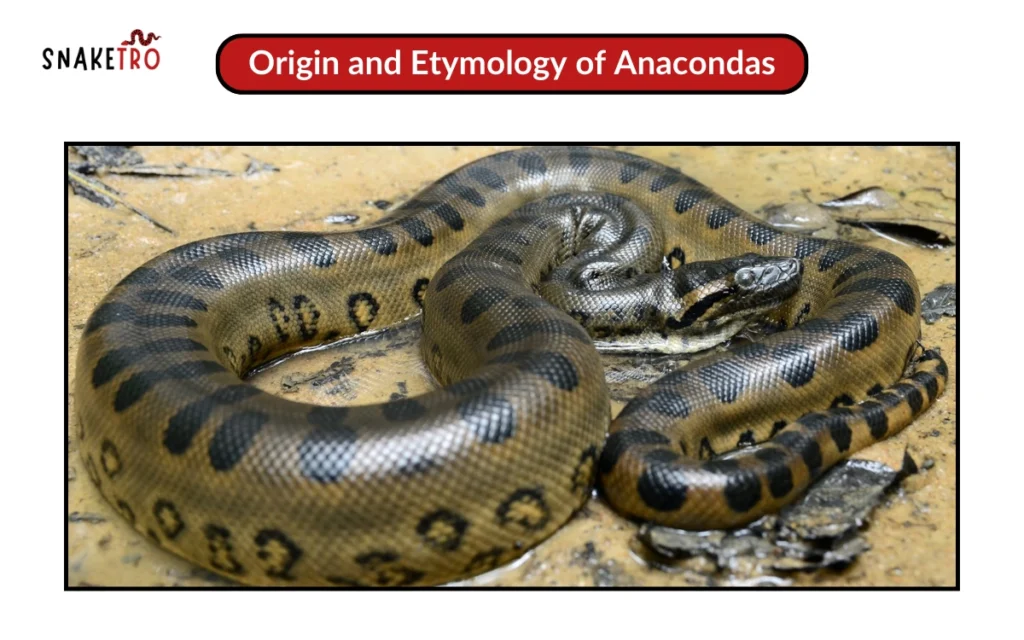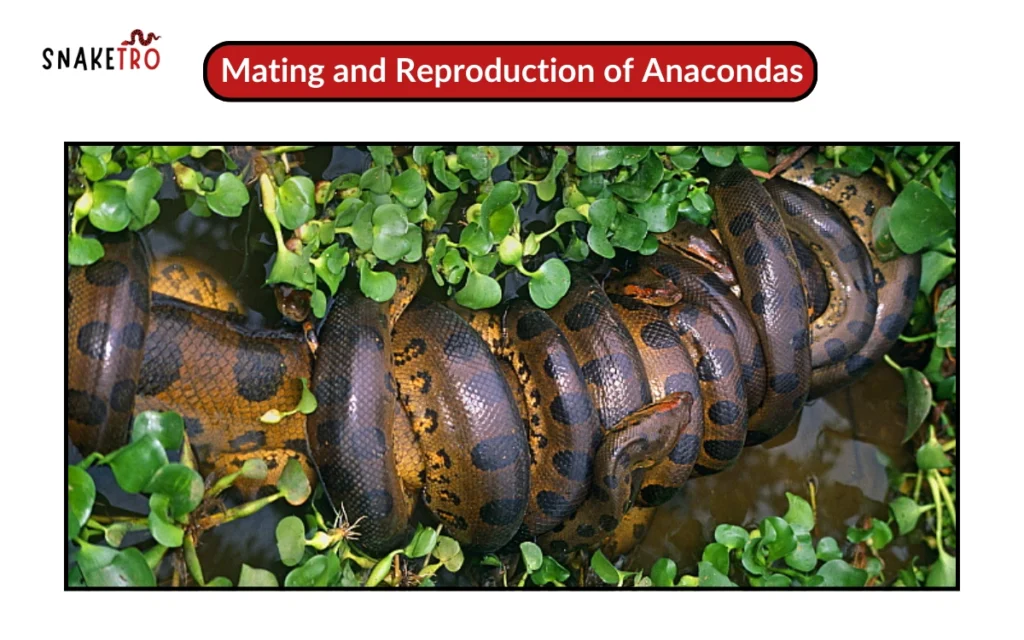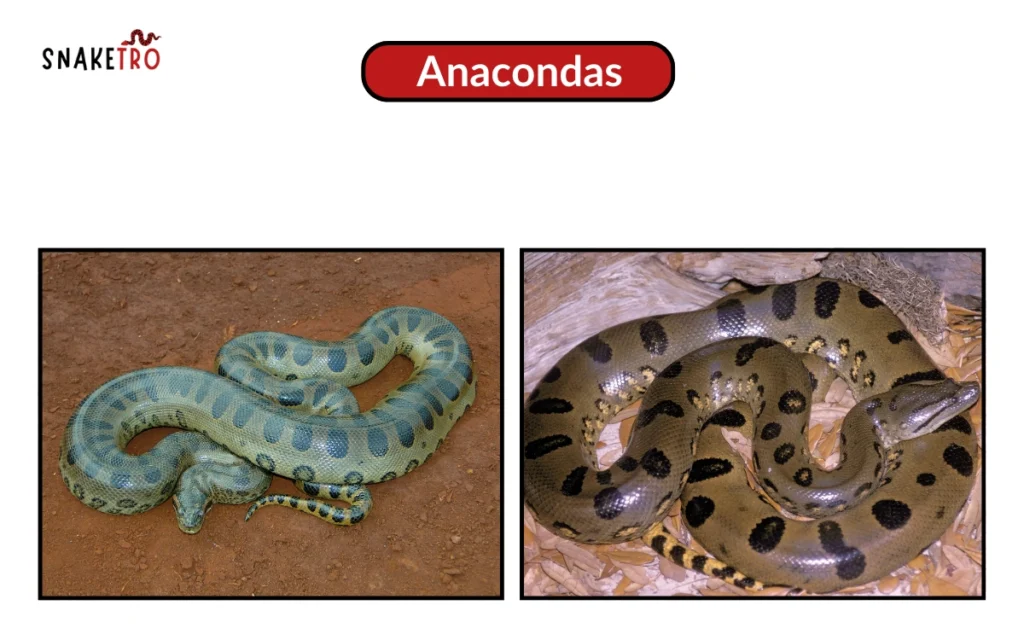History of Anacondas: A Dive into the World of the Largest Snake
Anacondas most likely rise to mind when you feel large, dangerous animals hiding in the South American jungles. There is something both amazing and dangerous about these snakes, which are among the biggest in the world. Let’s examine their past, their interactions with people, and what it means to own one in more detail.
Table of Contents
Origin and Etymology of Anacondas
The South American tropical jungles, especially those in the Amazon and Orinoco river basins, are home to the anaconda. It is thought that the word “anaconda” comes from the Tamil word “anaikolra,” which means “elephant killer,” though this is up for controversy. In reality, while they are formidable hunters, their prey rarely includes anything as large as an elephant!

Since anacondas are to the boa family, they are related to the boa constrictor, another well-known large snake. It is regularly believed that the green anaconda is smaller and lighter than it actually is. They may not be as long as some other snake species, such as the reticulated python, but it’s clear why they’re often referred to as the heaviest snake in the world.
Distribution and Habitat of Anacondas
Anacondas thrive in tropical South America, where their natural habitat includes rivers, fields, and marshes. Being semi-aquatic, they are incredibly qualified swimmers, and you’re more likely to find them Moving beneath the water’s surface than slithering across the jungle floor. The green anaconda, the largest of its kind, is mostly found in the Amazon.
Unfortunately, anaconda populations, like those of many other species, are under attack by habitat loss. Anaconda care is a very involved and costly effort, so it’s important to consider the amount of space and resources these animals require, all the way to cages. The surrounding costs of anacondas, for example, can be extremely high due to the size and unique biology of the snake.
Feeding Habits of Anacondas
Anacondas are constrictors, they kill their prey by surrounding them with their powerful bodies and applying pressure until the victim is unable to breathe. Birds, fish, small animals, and occasionally larger prey like deer or caimans make up their diet. It’s amazing how they can swallow their prey fully and eat animals that are considerably larger than yourself.
Now, imagine that you are the proud owner of an anaconda as a pet (as some brave individuals do). Anacondas require a consistent diet of animals of the right size, so feeding costs can mount up quickly. If you’ve ever been tempted to keep such a big creature of horror, you should also think about the cost of maintaining an anaconda as a pet. I remember finding out about someone who attempted to maintain an anaconda in a suburban home, and the expenses were high, Nothing more to feed it!
Relationship Between Anacondas and Humans
Anacondas are generally not dangerous to humans, despite their difficult sight. Many stories and customs focus on their power and height, some of which describe them eating entire populations or attacking large gatherings of people. They occasionally assault people despite their great strength.
The price of anaconda permits is one item that caught me off guard while I was researching these snakes. Earning the legal right to own an anaconda in many countries, such as the USA, involves paying large fees and following stringent laws. This makes sense considering their possible danger and the environmental damage they could cause if released into non-native habitats.
Species of Anacondas Chart
There are four recognized species of anacondas:
| Species | Taxon Author | Common Name | Geographic Range |
| Eunectes akiyama | Rivas et al., 2024 | Northern Green Anaconda | Found in Ecuador, Colombia, Venezuela, Trinidad, Guyana, Suriname, French Guiana, and northern Brazil |
| Eunectes beniensis | Dirksen, 2002 | Bolivian Anaconda | Located in South America, particularly in the Departments of Beni and Pando in Bolivia |
| Eunectes deschauenseei | Dunn and Conant, 1936 | Dark-Spotted Anaconda | Native to northern Brazil and coastal French Guiana |
| Eunectes murinus | (Linnaeus, 1758) | Green Anaconda | Ranges across Peru, Bolivia, French Guiana, Suriname, and Brazil |
| Eunectes notaeus | Cope, 1862 | Yellow Anaconda | Distributed in eastern Bolivia, central-western Brazil, Paraguay, and northeastern Argentina |
| Eunectes stirtoni | Hoffstetter and Rage, 1977 | Extinct Species | Fossils found in the La Venta fauna (Miocene) in Colombia; validity of the species is questionable |
Mating and Reproduction of Anacondas
Because anacondas are ovoviviparous, they give birth to live children rather than laying eggs. After mating, the female anaconda can give birth to anywhere from 20 to 40 a child. with some litters having even more. The cost of keeping anacondas in captivity is another factor that would likely deter numerous possible pet owners. It can be expensive to maintain the conditions necessary for their reproduction, which include the right humidity and temperature.

Indigenous Mythology and Anacondas in the Amazon
In many South American cultures, anacondas are featured in traditional myths and stories. For native populations in the Amazon, the anaconda is often seen as a powerful spirit animal. There are also myths that say rivers and other bodies of water formed by anacondas.
The myth of the Blood Orchid, a flower that is supposed to bloom in the Amazon and grant anacondas incredible strength and quality of life, attracted my interest. actually the lack of scientific backing for these stories, it’s amazing to observe how these massive animals have inspired local legends.
How Much Does an Anaconda Cost?
If you’re still interested in owning one of these massive snakes, you should know that the cost of buying a green anaconda can range from hundreds to thousands of dollars, depending on the source and age of the snake. Then there’s the ongoing cost of anaconda habitat maintenance, which includes everything from enclosure heating costs to feeding and healthcare. Even the cost of legal permits required to own one in some areas can be significant.
If you ask me, after researching the cost of keeping an anaconda in captivity, I think it’s one of the most expensive pets you could ever own. From enclosure building to the cost of veterinary care, you’re looking at a serious investment.
Final Thoughts
Whether you’re simply fascinated by these creatures or seriously considering the immense responsibility of owning one, anacondas remain a symbol of nature’s power and mystery. They are the stuff of legend and continue to capture our imaginations. From their role in Amazonian folklore to their sheer physical presence, it’s easy to see why they are both feared and admired.
But if you’re like me, the reality of owning one especially after learning about the costs of keeping an anaconda is probably best left to the professionals.
Faqs
What is an anacondas?
Anacondas are large, non-venomous snakes native to South America, known for their impressive size and strength. The most recognized species is the green anaconda, which is often considered the largest snake in the world.
How big do anacondas get?
Anacondas can grow to impressive lengths, with green anacondas averaging 20-30 feet in length, and some individuals even exceeding 30 feet. They can also weigh over 500 pounds, making them one of the heaviest snake species.
Are anacondas dangerous to humans?
While anacondas are powerful predators, they typically avoid humans and are not considered a significant threat. However, they can be dangerous if provoked or threatened, as they are capable of constricting large prey.
Where do anacondas live?
Anacondas are primarily found in tropical rainforests, swamps, and marshes across South America, especially in countries like Brazil, Venezuela, Colombia, and Peru.
What do anacondas eat?
Anacondas are carnivorous and have a diverse diet that includes fish, birds, mammals, and even other reptiles. They hunt by ambushing their prey and using their powerful bodies to constrict and swallow them whole.
How much does it cost to own an anaconda?
The cost of owning an anaconda can vary significantly based on species and size. Factors include the purchase price, habitat setup, maintenance, veterinary care, and feeding. Generally, costs can range from several hundred to several thousand dollars.
What are the different species of anacondas?
The primary species include the green anaconda, yellow anaconda, Bolivian anaconda, and dark-spotted anaconda. Each species has unique characteristics and habitat preferences.
Can anacondas swim?
Yes, anacondas are excellent swimmers and are often found in water. Their bodies are adapted for aquatic life, and they can hold their breath for long periods while hunting underwater.








1 thought on “What Are anacondas? Discover Their Species, Habitats, and Costs”